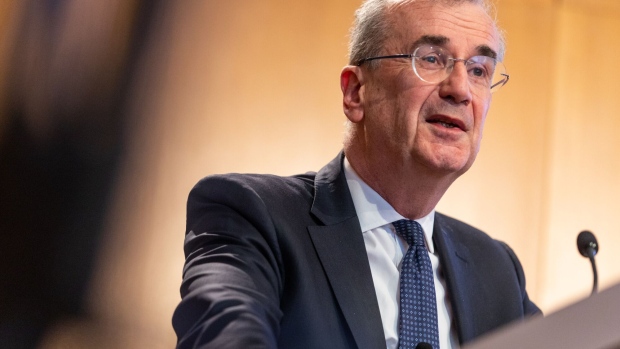Mar 28, 2024
ECB’s Villeroy Flags Economic Risks of Cutting Rates Too Late
, Bloomberg News

(Bloomberg) -- The European Central Bank can’t ignore the economic risks of keeping interest rates high for too long and should begin cutting at one of its next two meetings, according to Governing Council member Francois Villeroy de Galhau.
The French central banker said that while there’s no doubt about the ECB’s determination to return inflation to the 2% target, it should now integrate a secondary objective of ensuring a so-called soft landing for the 20-nation euro-zone economy.
That outcome would be better for incomes, jobs and public finances, while waiting too long to act could oblige the ECB to cut even more aggressively in the future, he said, backing a first move in April or June.
“Risks to inflation are now balanced, but risks to growth are on the downside,” Villeroy said in a speech on Thursday. “The time has come to take out an insurance against this second risk by beginning rate cuts.”
The Bank of France governor joins dovish policymakers who’ve raised alarms this week about the damage the ECB’s record high borrowing costs could do to the economy.
His Italian counterpart, Fabio Panetta, said on Thursday that policy is compressing demand. A day earlier, Executive Board member Piero Cipollone said that if data confirm the ECB’s forecasts for weaker growth and inflation, it should stand ready to “swiftly dial back” its restrictive stance.
With analysts estimating inflation dipped to 2.5% this month, most officials have backed President Christine Lagarde’s signal of a first rate cut in June. Economists and markets share that expectation, with investors almost fully pricing a reduction to 3.75% from 4% at the ECB’s June 6 meeting.
Villeroy is among a small group saying a move at April’s gathering is still possible, while acknowledging June is more likely.
“The exact date of the first cut — April or early June — has no existential importance,” Villeroy said on Thursday. “I repeat my belief that it should happen in the spring, and independently of the calendar of the Federal Reserve.”
He said that while there is a “certain parallelism” between the inflationary cycles in the US and Europe, they don’t have exactly the same causes, timetable or levels.
“We speak to each other, but each central bank decides based on the economic situation at home,” Villeroy said. “In terms of the disinflation dynamic, the weather conditions this spring aren’t necessarily the same on both sides of the Atlantic.”
Read more: Waller Says Fed Should Delay or Reduce Cuts After New Data
With the debate in Europe now shifting to the pace of subsequent cuts, Villeroy said the ECB will be pragmatic and guided by data. While that doesn’t mean it will reinstate “excessive forward guidance,” he said the central bank won’t be tied to a strict “meeting-by-meeting” approach and that its forecasts will become more important relative to backward-looking indicators.
“We’ll probably start with a moderate cut,” he said. “After that, we won’t be obliged to reduce rates at every Governing Council, but we should keep that option.”
Regarding how far the ECB will ultimately go, Villeroy said it has a significant margin to lower rates before policy stops being restrictive or becomes too accommodative.
“This is another reason to prefer agile gradualism to excessive wait-and-see,” he added.
(Updates with Villeroy comments on Fed starting in 10th paragraph.)
©2024 Bloomberg L.P.





